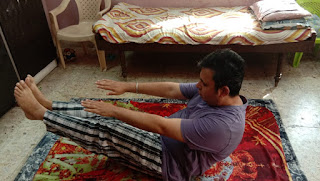Triangle Pose or Trikonasana – How to do, Benefits, Contraindications
Triangle Pose or Trikonasana – Steps, Benefits, Contraindications
Trikona means ‘Triangle’ and ‘Asana’ means pose. In
Trikonasana or Triangle Pose, we try to form the shape of body like a triangle. Let us see Triangle Pose or Trikonasana - Steps, Benefits,Contraindications.
Trikonasana or Triangle Pose has four variations:
·
Extended Triangle Pose or Utthita Trikonasana
·
Bounded Triangle Pose or Baddha Trikonasana
·
Revolved Triangle Pose or Parivrtta Trikonasana
·
Reclining Triangle Pose or Supta Trikonasana
Today we will see Revolved Triangle Pose (Parivrtta
Trikonasana). In this asana we have to keep our eyes open, so that body balance
is maintained.
 |
| Parivrtta Trikonasana or Revolved Triangle Pose Left Side |
 |
| Parivrtta Trikonasana or Revolved Triangle Pose Right Side |
How to do Parivrtta Trikonasana or Revolved Triangle Pose
·
Make to sure to do a good warm up exercise of
whole body before performing Parivrtta Trikonasana.
·
Stand in mountain pose with both the feet together
and arms as straight as possible resting on sides.
·
Inhale and bring your left feet back. Raise the
left arm up towards the ceiling. Exhale.
·
Bend and twist your body towards right side. Try
to touch your right ankle with left hand. If you are more flexible, try to keep
your left hand besides right feet on floor. With practice flexibility can be achieved.
·
Raise your right arm as straight as possible for
you in line with your shoulders. Turn your head and try to look your right hand.
·
Hold the pose for 3 breaths.
·
Breathe, Exhale. Bring right hand down. Gently
release the twist and come back to the original starting position.
·
Now do it other way i.e. Inhale and bring left
feet forward. Raise your right arm. Bend and twist your body.towards left. Try to touch the left ankle or feet
with right arm. Raise left arm keeping it in line with shoulders. Turn your head
and try to look towards your left hand. Hold this pose for 3 breaths. Exhale and
Release the twist. Come back to original standing position.
·
Take few deep breaths.
Benefits of Parivrtta Trikonasana or Revolved Triangle Pose
·
It strengthens legs, knees, ankles, arms and
chest.
·
It stretches and open the hips, groins,
hamstrings, calves, shoulders, chest and spine.
·
It increases mental and Physical equilibrium.
·
It helps improve digestion.
·
It reduces anxiety and stress.
·
It reduces back pain and sciatica.
Contraindications of Parivrtta Trikonasana or Revolved Triangle Pose
·
Avoid this pose, if you have migraine, diarrhea,
low or high blood pressure. People with high blood pressure can do this pose
without raising their hand overhead. It may further raise the blood pressure.



Comments
Post a Comment